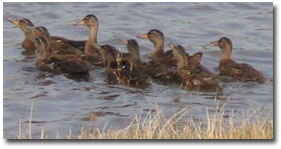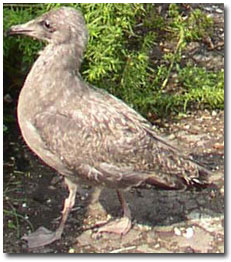
Questions and Answers

- WHAT IS AVIAN INFLUENZA?
Avian Influenza (AI) is a viral disease that affects the respiratory and digestive systems of most species of domestic and wild birds. AI is characterized into two basic forms: High Pathogenicity Avian Influenza (HPAI) – a rapidly fatal form of AI among birds, and Low Pathogenicity Avian Influenza (LPAI) - a mild, often undetected form of the disease that frequently occurs in wild bird populations.
- AI TERMS ARE CONFUSING – WHAT IS THE DIFFERENCE BETWEEN H5N1, BIRD FLU, PANDEMIC FLU AND SEASONAL FLU?
H5N1 Surface proteins on avian influenza viruses are classified as H – Hemagglutinin and N – Neuraminidase. There are 16 H and 9 N types affecting birds. The possible combinations of H & N surface proteins create the numerous strains of AI such as the Asian HPAI H5N1 currently affecting poultry, people and some wild birds in Europe, Africa and Asia. H5N1 is a form of HPAI, however, not all H5N1 avian viruses are HPAI.
Bird Flu A generic term that is being used by the press to describe all avian influenza types especially the H5N1/ HPAI form of AI in Asia and Europe affecting people and poultry. Using one generic term can cause confusion and undue concern because of the differences between the naturally occurring varieties in birds and the worries about a potential pandemic flu.
Pandemic Flu A flu that spreads from person-to-person affecting large numbers of people across countries.
Seasonal Flu The strain of influenza virus that affects people each winter. Strains of this type often change year to year. Vaccines are produced to prevent these types of human flu viruses in people. In the U.S. each year approximately 30,000 people die from seasonal human flu strains (mostly geriatric, pediatric and immunocompromised individuals).
- WHAT ARE THE SIGNS OF AI IN WILD BIRDS?
LPAI in wild birds is usually not detected since signs are mild. Signs may include or respiratory distress, intestinal distress and lethargy.
For information on AI in Maryland poultry and humans, please consult the Maryland Department of Agriculture (MDA) (www.mda.state.md.us) and the Maryland Department of Health & Mental Hygiene (DHMH) - (www.dhmh.state.md.us and www.edcp.org).
- WHAT SPECIES OF WILD BIRDS ARE AFFECTED BY AI?
All birds are susceptible. Waterfowl, shorebirds, marine birds and upland game birds are known carriers of the LPAI form of avian influenza.
- WHERE IS AI FOUND?
The Asian HPAI H5N1 has not been found in
Maryland or anywhere in the U.S and Canada (not in people, poultry or wild
birds). LPAI is routinely found in health and disease surveillance of wild birds in Maryland, North America and around the world. Occasionally, LPAI is found in U.S. poultry – such as the LPAI outbreaks in Delaware and Maryland poultry farms in 2004. National studies for early detection of the Asian HPAI H5N1 in wild birds are under way across the nation.
- HOW IS AI TRANSMITTED IN BIRDS?
AI is passed between birds through fecal material and body fluids such as saliva, nasal secretions and aerosol droplets. In Southeast Asia poultry may have spread HPAI to wild birds through contact with domestic chickens, ducks and geese raised outdoors.

- CAN AI BE TRANSMITTED TO OTHER ANIMALS?
While AI may be transmissible to other animals it does not move between species readily. Species known to be positive for AI include marine mammals, marten, horses, pigs and cats.
- CAN AI BE TRANSMITTED TO PEOPLE?
Avian Influenza has not been transmitted from wild birds to humans. The current outbreaks in Asia, Europe and Africa are between captive poultry and people. Since 2003 approximately 250 individuals have been affected with the Asian HPAI H5N1 strain of the influenza virus causing mortality in about half of these people. In the current outbreaks in Eurasia, human-to-human transmission has not been documented. Previous worldwide human pandemic flu outbreaks, such as the one in 1918 involved human-to-human transmission and killed millions of people. However, health care and living conditions in the U.S. have improved dramatically since that time, and human influenza vaccines and antibiotics are now readily available. Hopefully, any future outbreaks in people may not be as severe as in the past. For more information on Maryland’s preparedness for a pandemic flu visit flu.maryland.gov; and www.dhmh.state.md.us. Additional sources of information can be found at the end of this document.
- DO ANIMALS RECOVER FROM AI?
Animals can recover from LPAI, and may become carriers. However, birds typically do not survive HPAI infections.
- CAN AI BE PREVENTED?
Wild Birds: The LPAI form is endemic in free flying wild birds and cannot be prevented. While many birds migrate long distances and may spread LPAI within wild populations, LPAI from wild birds is not readily transmitted to poultry and has not been transmitted to humans. In Asia, captive poultry raised outdoors may have transmitted HPAI to wild birds. Biosecurity on poultry farms, in live bird markets, and in international trade is the key to prevention of AI.
Poultry: The Maryland Department of Agriculture (MDA) works closely with the Delmarva Poultry Industry (DPI), individual poultry growers and the USDA to keep all forms of AI from entering Maryland poultry flocks. Prevention, control and eradication programs for poultry facilities are established and in place in MD, DE, VA and across the country. Plans are implemented for depopulation and disposal of infected, poultry, as well as the establishment of surveillance and certification programs, public education, outreach and training. The Maryland Department of Natural Resources cooperates with all poultry and human health agencies and assists with testing and eradication efforts when needed. For information on AI in poultry, visit www.mda.state.md.us.
- WHAT IS BEING DONE TO MONITOR AI IN MARYLAND?
The Maryland Department of Natural Resources (MD DNR) has been working closely with federal, state and local partners, including USDA, National Wildlife Health Center, USGS/ National Wildlife Refuges, National Parks Service, University of MD, Ohio State University, MDA, DHMH and local wildlife rehabilitators) to conduct active and targeted surveillance for AI in wild birds since June 2005 and will continue to expand monitoring efforts. Our collective efforts will combine with national and international efforts in monitoring wild bird populations to protect domestic animals and public health.
- WHAT PRECAUTIONS SHOULD BE TAKEN WHEN HANDLING WILD BIRDS AND CARCASSES?
Avian Influenza poses no risk to bird watchers. Persons handling live wild birds should take normal precautions such as washing hands and cleaning capture and banding equipment. As with all advisories for consumption of wild game meat, hunters are advised not to consume meat from animals known to be ill or have visible lesions. Specifically, bird handlers and hunters may take simple precautions such as:
- Avoid handling birds that appear to be ill
- Wear gloves when handling birds or field dressing carcasses
- Do not eat, drink or smoke when handling birds or carcasses
- Wash hands and instruments thoroughly after field dressing is completed
- Clean all tools with hot, soapy water and disinfect surfaces with 10% bleach solution
- Wash hands with soap and water or alcohol wipes
- Thoroughly cook meat to at least 165°
- Properly dispose of waste from carcasses
- HOW CAN CITIZENS HELP?
You can help MD DNR monitor the health of Maryland’s wild bird populations by reporting die-offs of large numbers of birds in your area to the MD DNR toll free number 1-(877) 463-6497. During hunting seasons, biologists may ask hunters for permission to collect samples from harvested waterfowl and other birds.
- WHERE CAN I GO TO GET MORE INFORMATION ON AI?
Everything You Wanted to Know About Avian
Influenza
flu.maryland.gov - State of Maryland Official Flu Website
www.dhmh.state.md.us - MD Department of Health & Mental Hygiene
www.mda.state.md.us - Maryland Department of Agriculture
www.dnr.state.md.us/wildlife/AV_Hunters.asp - Maryland Department of Natural Resources
www.nwhc.usgs.gov - National Wildlife Health Center / USGS
www.scwds.org - University of Georgia / Southeastern Cooperative Wildlife Disease Study
1 (877) 463-6497 USDA Wildlife Services & Maryland Department of Natural Resources Toll-free Call Center (M-F 8-4:30)
1 (877) 620-8DNR x 8540 Maryland Dept. of Natural Resources - Wildlife & Heritage Service (M-F 8-4:30)
1 (410) 226-5193 x138 Maryland Dept. of Natural Resources - Fish & Wildlife Health Program (M-F 8-4:30)
1 (800) 628-9944 Maryland Dept. of Natural Resources - Toll-free Emergency Call Center (24 /7)
Other Links to Information About Avian Influenza and Pandemic Flu
US Fish & Wildlife Service Avian Influenza Information www.fws.gov/migratory birds/issues/AvianFlu/WBAvianFlu.htm
AVMA Scientific Backgrounder www.avma.org/public_health/influenza/default.asp
The official U.S. Government Web Site on Pandemic Flu and Avian Influenza
http://pandemicflu.gov/
USDA Avian Influenza www.usda.gov/wps/portal/usdahome?navtype=SU&navid=AVIAN_INFLUENZA
WHO Avian Influenza Frequently Asked Questions
http://www.who.int/csr/disease/avian_influenza/ avian_faqs/en/index.html#poultry
Centers for Disease Control & Prevention www.cdc.gov/flu/avian/index.htm
What Hunters Should Know About Avian Influenza (Bird Flu)
http://www.dnr.state.md.us/wildlife/AV_Hunters.asp
Avian Influenza & Wildlife-Questions and Answers
http://www.dnr.state.md.us/wildlife/AV_QA.asp
Avian Influenza: Are Hunting Dogs at Risk of Getting Bird Flu?
http://www.dnr.state.md.us/wildlife/AV_HuntingDogs.asp Everything You Wanted to Know About Avian
Influenza
http://www.dnr.state.md.us/dnrnews/infocus/everything_about_AI.html
|
|
|



